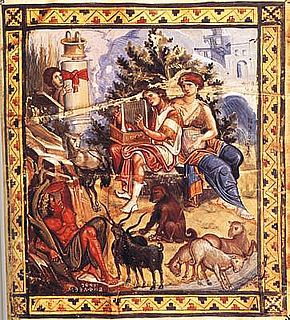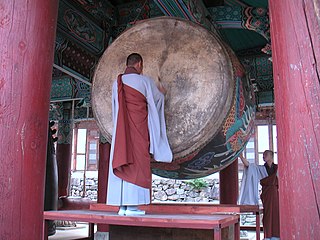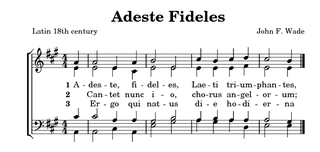 W
WReligious music is a type of music that is performed or composed for religious use or through religious influence. It may overlap with ritual music, which is music, sacred or not, performed or composed for or as ritual.
 W
WCeremonial drums are membranophones and idiophonic slit drums, which are played in a ritual context cult, religious or ceremonial social occasions by indigenous peoples around the world, often accompanied by singing or chanting.
 W
WChristian music is music that has been written to express either personal or a communal belief regarding Christian life and faith. Common themes of Christian music include praise, worship, penitence, and lament, and its forms vary widely across the world. Church music, hymnals, gospel and worship music are a part of Christian media, and also include contemporary Christian music which itself supports numerous Christian styles of music, including hip hop, rock, contemporary worship, and urban contemporary gospel.
 W
W"Christians, awake, salute the happy morn" is an English Christmas hymn on a text by John Byrom. It is usually sung to the tune "Yorkshire" by John Wainright.
 W
WThe dithyramb was an ancient Greek hymn sung and danced in honor of Dionysus, the god of wine and fertility; the term was also used as an epithet of the god. Plato, in The Laws, while discussing various kinds of music mentions "the birth of Dionysos, called, I think, the dithyramb." Plato also remarks in the Republic that dithyrambs are the clearest example of poetry in which the poet is the only speaker.
 W
WA firzogerin,, alternately vorsangerin, foreleiner, zugerin, or zugerke, was a historic role in the synagogue for a learned Jewish woman leading women in prayer from the weibershul as a precentress, parallel to the main service led by a male chazzan.
 W
WA hazzan or chazzan is a Jewish musician or precentor trained in the vocal arts who helps lead the congregation in songful prayer. In English, this prayer leader is often referred to as a cantor, a term also used in Christianity.
 W
WHindu music is music created for or influenced by Hinduism. It includes Indian classical music, Kirtan, Bhajan and other musical genres. Raagas are a common form of Hindu music in classical India.
 W
WA hymn is a type of song, usually religious and partially coincident with devotional song, specifically written for the purpose of adoration or prayer, and typically addressed to a deity or deities, or to a prominent figure or personification. The word hymn derives from Greek ὕμνος (hymnos), which means "a song of praise". A writer of hymns is known as a hymnist. The singing or composition of hymns is called hymnody. Collections of hymns are known as hymnals or hymn books. Hymns may or may not include instrumental accompaniment.
 W
WA hymn tune is the melody of a musical composition to which a hymn text is sung. Musically speaking, a hymn is generally understood to have four-part harmony, a fast harmonic rhythm, with or without refrain or chorus.
 W
WLiturgical music originated as a part of religious ceremony, and includes a number of traditions, both ancient and modern. Liturgical music is well known as a part of Catholic Mass, the Anglican Holy Communion service and Evensong, the Lutheran Divine Service, the Orthodox liturgy and other Christian services including the Divine Office. Such ceremonial music in the Judeo-Christian tradition can be traced back to both the Temple in Jerusalem and synagogue worship of the Hebrews.
 W
WIndigenous music of North America, which includes American Indian music or Native American music, is the music that is used, created or performed by Indigenous peoples of North America, including Native Americans in the United States and Aboriginal peoples in Canada, Indigenous peoples of Mexico, and other North American countries—especially traditional tribal music, such as Pueblo music and Inuit music. In addition to the traditional music of the Native American groups, there now exist pan-Indianism and intertribal genres as well as distinct Native American subgenres of popular music including: rock, blues, hip hop, classical, film music, and reggae, as well as unique popular styles like chicken scratch and New Mexico music.
 W
WNeopagan music is music created for or influenced by modern Paganism. Music produced in the interwar period include efforts from the Latvian Dievturība movement and the Norwegian composer Geirr Tveitt. The counterculture of the 1960s established British folk revival and world music as influences for American neopagan music. Second-wave feminism created women's music which includes influences from feminist versions of neopaganism. The United States also produced Moondog, a Norse neopagan street musician and composer. The postwar neopagan organisations Ásatrúarfélagið in Iceland and Romuva in Lithuania have been led by musicians.
 W
WShamanic music is music played either by actual shamans as part of their rituals, or by people who, whilst not themselves shamans, wish to evoke the cultural background of shamanism in some way. Therefore, Shamanic music includes both music used as part of shamans' rituals and music that refers to, or draws on, this.
 W
WShinto music is the ceremonial and festive music of Shinto (神道), the indigenous religion of Japan. Its origin myth is the erotic dance of Ame-no-Uzume-no-Mikoto which lured Amaterasu from her cave.
 W
WThe Fes World Festival of Sacred Music is an annual music festival that is held for a week in Fes, Morocco. It was first held in 1994.
 W
WZoroastrian music is a genre of religious music that accompanies religious and traditional rites among the Zoroastrian people.